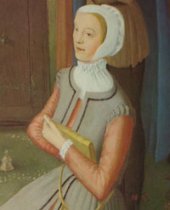
In 1913, Mrs Joseph Chichester was instrumental in starting the work of The UCM on her property, Calverleigh, near Tiverton, Devon. Ethelreda was the youngest daughter of a family of 12, six boys and six girls. For many years prior to 1913 there had been anxiety concerning the spiritual and moral conditions in many parts of England, especially in rural districts.
It was this state of affairs which led to the inauguration of the Anglican Mothers' Union. It was this that suggested the desirability of forming a similar Society on Catholic lines, which might prove a real service to the Church. With the help of her sister, Agnes, she drew up a scheme for a Union of Catholic Mothers and together they wrote the 'UCM Prayer', which received an indulgence from Cardinal Bourne and later from the Holy Father. Both the scheme and the prayer were submitted to the Archbishop of Birmingham who gave his sanction and approval. This was soon endorsed by the Hierarchy.
In 1913, at a meeting in Leeds, the CWL received the mandate from His Eminence Cardinal Bourne entrusting the carrying out of the scheme to the Catholic Women's League. The Cardinal considered that the UCM had something of its own to contribute - the insistence on the sacramental character and permanence of marriage, a Catholic education for their children and their training as public spirited citizens; and their active share of good works in the world, combined with a deep spiritual culture.
Ethelreda's mother, Lady Catherine Berkeley was the first UCM President, but it was a Mrs Radcliffe who came from Birmingham, and was elected as UCM President there, who became the most enthusiastic and energectic organiser. It was due to her that the work of The UCM took root.
The original groups were in Bath, Birmingham, Boscombe, Brighton, Cambridge, Hartlepool, Huddersfield, Liverpool, Newcastle, Salford and Woverhampton.
It was not until 1923 that The UCM was reorganised, although even then the formation of a foundation needed the consent of the local CWL.
At the time there were 22 foundations in Birmingham and 11 elsewhere. In 1927 there were 63 foundations, and in 1930 there were 105. By Easter 1935 this had increased to 205 around the country, with an approximate membership of 24,000. Martha Thornley who was President from 1930 to 1933 wrote: "Our Mothers have always given me their unfailing loyalty and devotion. When I was glad they rejoiced with me, when I was ill or in sorrow they prayed with me."
Dates may have changed but the loving family of The UCM is the same as it ever was.

St
Margaret Clitheroe
Patron Saint of the UCM
St Margaret Clitherow, patron saint of The UCM was born in 1556 and baptised in St Martin-le-Grand, Coney Street, where her father was churchwarden. In 1571 she married John Clitherow, a butcher, who had a shop in the Shambles.
Margaret became a Catholic in 1574 and from 1576 she sheltered Catholic priests, trained on the Continent, so that they could celebrate Mass for Catholics in York.
On 12 March 1586 her home in the Shambles was raided and she was arrested. She refused to plead at her trial because she didn't want others to share with her the guilt of her condemnation. The penalty for this was 'pein forte et dure' - pressing to death. This happened at the Toll booth beside the Ouse Bridge. Six weeks later her body was discovered by Catholics who carried it away and buried it with honour.
Nearly 400 years later, on 25 October 1970, Margaret Clitherow was declared a Saint by Pope Paul VI.
in 17 Dioceses in England and nearly
7,000 members.

In1996 a plaque was placed on the wall in the Shrine of St Margaret Clitherow in thanksgiving by The UCM for all the blessings received through the interecession of St Margaret Clitherow.